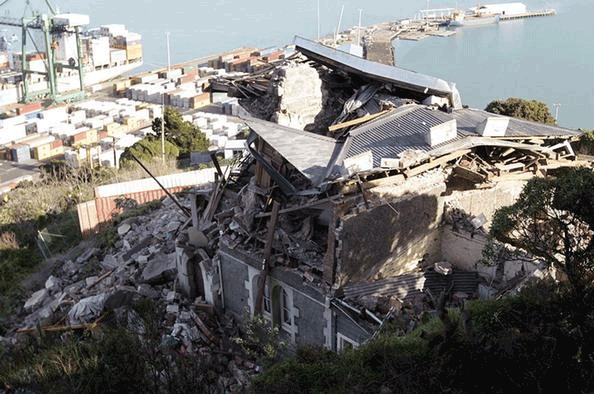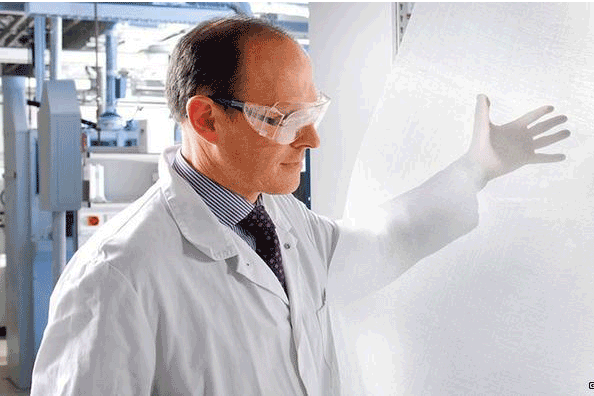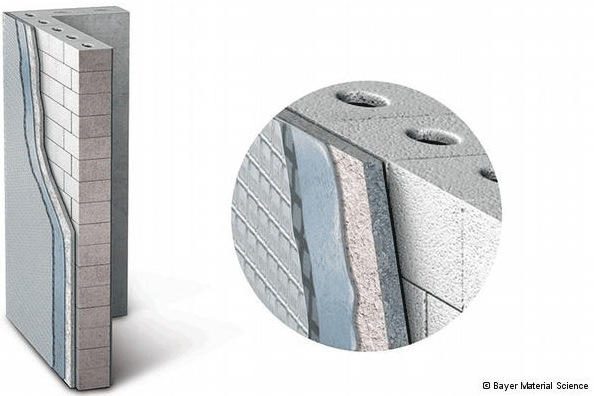|
German researchers have developed a millimeter-thin
wallpaper made of glass fibers that stabilizes walls shaken by
earthquake tremors. The product will be available this year.
"Intelligent composite seismic wallpaper" is the material's full name,
but its inventors refer to it simply as "earthquake wallpaper."
At first glance, the material looks like an endless placemat, which
someone has woven from plastic fiber: white, finely patterned and very
thin.
|
|
 |
|
It's difficult to imagine that the material can protect walls from
collapsing. Researchers at the Institute of Solid Construction and
Construction Material Technology at the Karlsruhe Institute of
Technology (KIT) claim it can do exactly that. The fine fabric is
designed to support walls and distribute the powerful forces released by
earthquakes across their entire surfaces and protect them from
collapsing.
Absorb earthquake tremors
Here is the trick: The material must be very firm yet at the same time
flexible and elastic enough to absorb the earthquake tremors. For this
reason, the fabric consists of two components, according to Mortiz
Urban, a co-developer and researcher at KIT: Very stiff, high-strength
glass fibers, on the one hand, are woven into the wallpaper with a very
thin, elastic polypropylene plastic, on the other. The fibers run in
four directions, ensuring that the energy is distributed evenly.
"Cracks are much more difficult," Urban said. The earthquake wallpaper
spreads the acceleration forces caused by an earthquake across a large
surface, he explained. As such, they can't concentrate on weak spots in
walls as they otherwise would. And should a strong earthquake cause
cracks in the wall, it won't collapse. "The fibers that run across the
surface straddle the cracks and close them like a rubber band," Urban
said.
|
|

|
|
If the earthquake is too strong, the glass fibers can tear apart, of
course. In this case, polypropylene works as backup security. It
prevents stones from falling from walls. Often, clumps of rocks and
collapsed walls hinder people from trying to escape damaged buildings
during earthquakes.
"With the wallpaper, we can give people the necessary time they need to
flee buildings or even to stabilize walls so they don't collapse," said
Lothar Stempniewski, director of the Institute of Solid Construction and
Construction Material Technology at KIT.
Like proper wallpaper, earthquake wallpaper can be applied to a
plastered wall, which can then be either painted or decorated with
normal wallpaper. Since the material is highly porous, damp walls and
the resulting mould pose no problems, according to Urban. Another
variant of the earthquake wallpaper allows buildings to be covered with
the material from the outside. "The fabric lies pressed in the exterior
plaster like a sandwich," he said.
Special adhesive
Typical wallpaper glue is not suited for fixing earthquake wallpaper.
Like the wallpaper, the glue must also be rock solid yet elastic. It
must firmly secure the wallpaper to the wall but also swing when an
earthquake tremor hits the wall. "Typical wallpaper adhesives are either
firm or elastic but not both," said Michael Engel, project direct at
Bayer Earth Science.
|
|

|
|
Bayer developed a special glue for this purpose, based on polyurethane.
A special feature is that within the adhesive, the chemical groups
interact in a mesh network via hydrogen bonding. Bonds loosened by the
tremors reform immediately at another spot but they don't tear apart.
"We have tested the fabric on a real house located on a vibrating
platform," KIT researcher Urban said. The researchers erected an
Italian-style stone building on a 35-quare-meter steel platform and then
proceeded to shake it. Without the fiber glass reinforcement, the house
would have been completely destroyed at a certain earthquake intensity.
"Because of the earthquake wallpaper, we were unable to make the
building collapse," Urban said. In fact, the house withstood another
earthquake test that was one and a half times more powerful.
"Our earthquake wallpaper is optimal for a medium-strong earthquake,"
Urban. The wallpaper, he added, is suitable only for brick buildings but
not those made of concrete, which the wallpaper can't stabilize.
Stronger carbon fibers are necessary for that. The German research team
is already working on this material.
"The system is ready," Bayer's Engel said. The product will launch for
global marketing this year. Initially, it will not be sold in home
furnishing stores but rather through partners supplying home builders
and craftsmen. Municipalities, particularly in earthquake regions such
as Turkey, Japan and Chile, should be encouraged to deploy the material
in hospitals, retirement homes and kindergartens.
More negotiations will be required in the world's poorer countries,
given the price of the earthquake wallpaper, which the product's
developers expect to cost more than normal wallpaper. And because the
product is to be applied initially by craftsmen, their work will add
further to the price. So it can be assumed that some time will pass
before earthquake wallpaper becomes a mass-market product. |